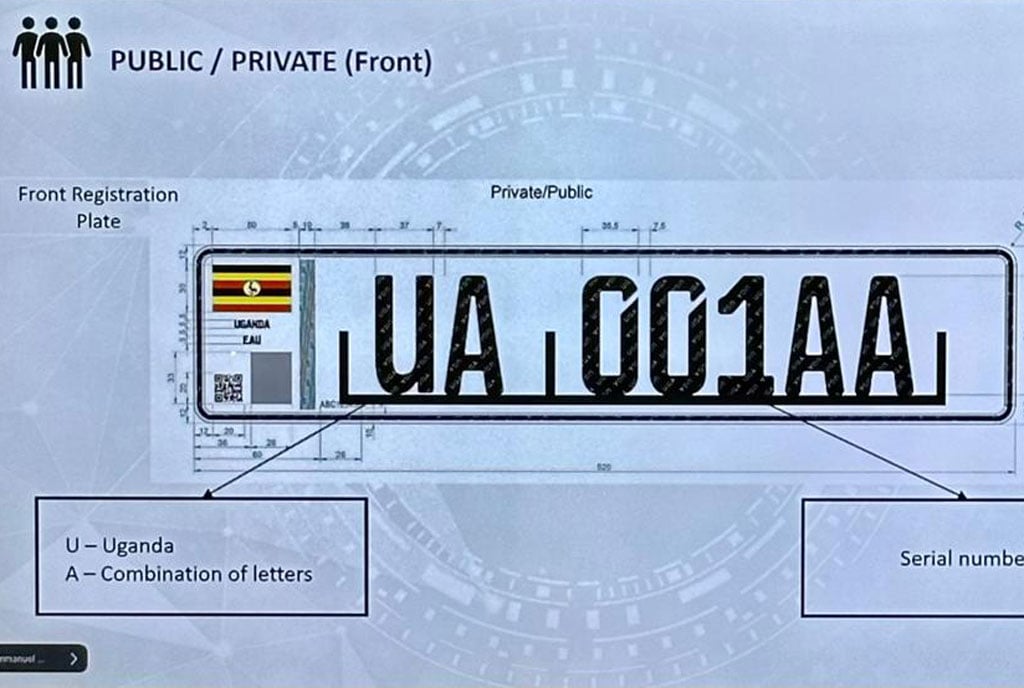Digital vehicle number plates: Let us keep a simple syntax

The planned new digital number plate(s). PHOTO/COURTESY
What you need to know:
- The industrial powers, the greatest polluters, should finance this initiative under the Climate Change Fund. Moreover, we are now the dumping ground for their fossil-fuel vehicles which they are off-loading from their ecosystems.
In the days when motor vehicles in my natal county were countable on the fingers of one hand, a near-fatal incident taught us a life-long lesson. We were on the usual chattering walk to school one sunny morning. And from nowhere, a shiny green ‘kamotoka’ (saloon car) screeched to a stop, as the driver swerved to avoid driving into us…we scampered, screaming wildly. Luckily, we all escaped unhurt.
Equally scared was the driver. He took off fast, as we gathered again onto the road. None of us in the motley crowd of 20 or so pupils could tell the owner of this strange car. It was unknown in the entire gomborora…all the cars in the gomborora were known by their owners.
Even the occasional ones such as the Bishop’s Peugeot 504, the priests at the parish, the priests born in the area, were known. And so was the ‘frog’ (Volkswagen beetle) of the veterinary assistant whenever he toured. This green shiny one, we didn’t know. As expected, none of us had captured its registration number. And this is where our headmaster, who doubled as school scouts master taught us a lasting habit.
We reported the incident to him during the scouts assembly. ‘Whenever a vehicle passes you, make sure you get its number…it is very important…not the colour, not the shape…but the number’, Sebastian Buzaare, our headmaster and scoutmaster imparted this into us. We obeyed him and it stuck for life.
The next week scouts assembly became a prize-winning occasion for whoever could tell the registration numbers of the vehicles in the sub-county and beyond. We even discovered that the green shiny kamotoka belonged to a son of the soil working in Kenya then, and had a strange registration number starting with ‘K’.
In lower secondary school, we would compete in rapping the registration numbers of all the vehicles in the diocese, with their respective departments and parishes.
Fast forward. October 2023. Uganda is launching the new digital number plates for motor vehicles, motorcycles and marine vessels . Digitalised for ease of tracking. Key factor is security. All perfect.
One key flaw: the registration number syntax. It may look exquisite, fanciful and cool, but it is a loser when it comes to matters security. Whereas it is stated that one digit or letter will be a ‘chip’ linking to the security tracking system, this is the ideal.
The reality has its limits, as we have experienced with our street security cameras. The greatest security gadget remains the human eye. We are still analog in all senses of the word. The reach of this tracking system will have limits, technical and otherwise. The current registration number syntax is manageable in terms of ‘cramming’ by the human eye.
Reinforced by commuter taxis having registration numbers on either body side, large and legible at a distance, boda-boda taxis having both front and rear number plates, trailers and lorries having registration numbers on the sides and tarpaulins.
The new syntax is too complex for quick capture by the human eye. It can stay simple but digital with the tracking system integrated. It is not too late to reconsider the syntax. Another possible ‘human eye’ security strategy would be registration by region.
A simplified alpha-numeric system would identify vehicles by their region of registration, easing rapid identification of vehicles ‘non-native’ to a given region. And from a political economy angle, vehicle number plates in Kenya are manufactured by prisons service. Wouldn’t our UPDF’s NEC do the same here, even with the security element considered?
In a related scenario, can we have the catalytic converter as an integral component of the new system? This is a device fitted in the exhaust system of a vehicle to neutralise combustion fumes, thus minimise the effect of carbon emissions.
The industrial powers, the greatest polluters, should finance this initiative under the Climate Change Fund. Moreover, we are now the dumping ground for their fossil-fuel vehicles which they are off-loading from their ecosystems.
The relevant government ministries and agencies here should consider this factor. Fossil fuels are with us for the foreseeable future. Carbon-effect mitigation is possible, as we move to elimination.
Matsiko Kahunga, [email protected]



